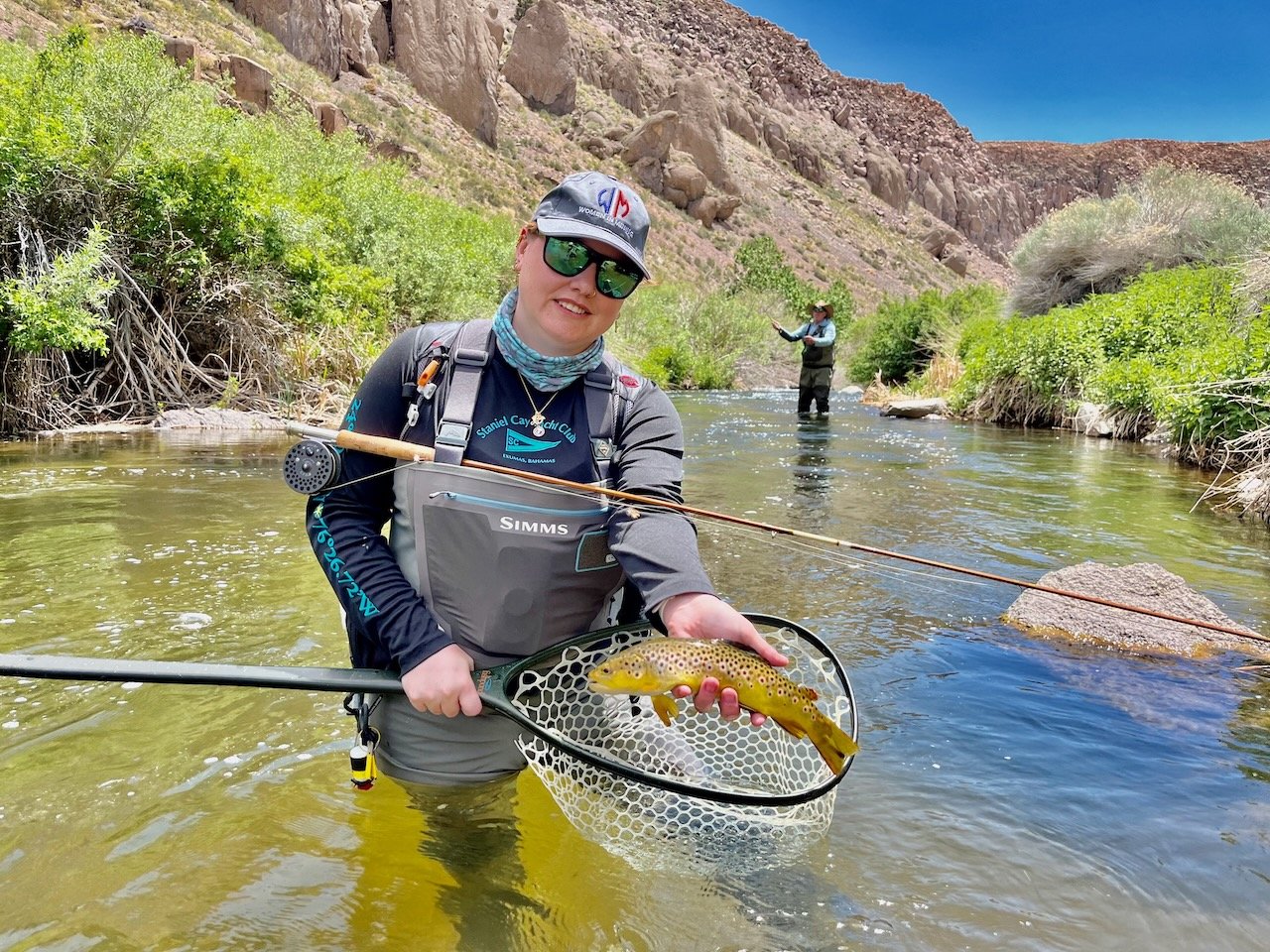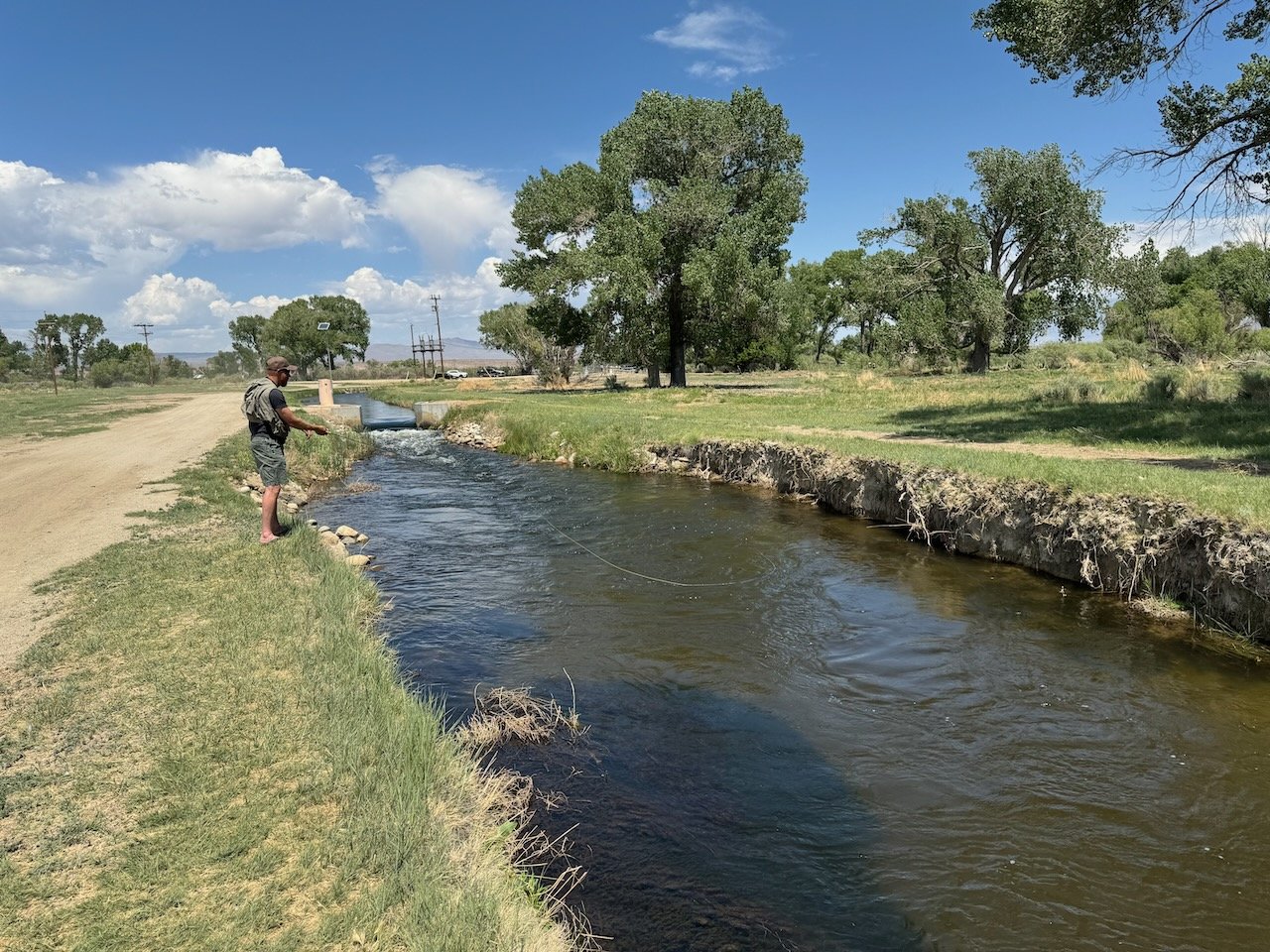Spring winds and rains continue to hamper fly fishers pursuing trout in the Eastern Sierra. June is the month with the greatest number of hatching aquatic insects and is a great time to be on the water fly fishing with dry flies As May comes to a conclusion mayflies, caddis flies and midges are hatching and the trout are feeding on them. Runoff has started in some waters, but it is not hampering fly fishing yet! Now is the time to visit the Eastern Sierra to nymph or dry fly the streams and lakes.
The cutthroats run in the upper Owens River is coming to an end, but there are a few trout still taking nymphs.
Lower Owens River
Wild Trout Section:
Flows of 575 CFS continue to keep fly fishers off the river. A dry fly fished on the surface might yield a fish or two if your fishing the spots accessible from the banks of the lower Owens River. Wading is unsafe at these flows.
Lower Owens River flows are up to 575 CFS which is too high to safely wade and fly fish the spots that are only accessible by wading.
Owens River Gorge
Middle Gorge Power Plant:
Wild browns from eight to 12 inches are feeding on nymphs and dries. This is a classic place to fish a dry and dropper rig. Adams parachutes, elk hair caddis and stimulators in sizes 14 and 16 are great dry flies to fish above the nymph These flies are highly visible and high floating. For the nymphs use size 18 bead head flash back pheasant tail nymphs, size 16 bead head flash back gold ribbed hare’s ears and size 16 copper Johns. Rattle snakes are active this time of the year in the gorge and fly fishers should be aware of where they step or put their hands. Stinging nettles are bushing out and fly fishers need to pay attention where their arms and hands are when casting and controlling line.
Kirsten Albino from Round Mountain, NV showing off an Owens River Gorge brown trout.
Hot Creek
Interpretive Site:
Dirty rising waters marks the influence of Mammoth Creek on Hot Creek as runoff has started. Fishing has been tough as there are few insects hatching and the ever present wind is blowing the hatching insects off the surface before the trout can feed on them. Nymphing is producing a few fish, but not like normal. With the heavier flows an indicator is the best way to present a nymph to the trout. The amount of weight needed to keep the nymph bouncing on the substrate is greater than a dry fly can float. Size 20 and 22 tiger midges and zebra midges, size 18 bead head flash back pheasant tail nymphs, size 18 olive quilldigons, size 12 olive scuds and size 12 olive burlap caddis are fooling the trout that are feeding on nymphs.
George Alvbno from Telluride, CO. fishing a size 14 orange stimulator and a size 18 bead head flash back pheasant tail nymph on a dry and dropper rig in Hot Creek Canyon.
Hot Creek
Canyon Section:
The no-see-ums on Hot Creek in May eat me up. I’ve got lots of bites around the hair line on my head. The trout in the canyon tend to take flies more reactively than the trout in the interpretive site which have more time to scrutinize the flies. A dry and dropper is working in the canyon depending on the flows created by the snow runoff. It depends on the amount of weight needed to keep your fly bouncing on the substrate. If the weight is more than the floatability of the dry fly then the fly fisher will need to use an indicator instead of a dry fly. Blue wing olives and gray caddis are the insects hatching that the trout are feeding on. For the nymphs fish with size 18 olive quilldigons, size 18 bead head flash back pheasant tail nymphs, size 18 Frenchie’s, size 18 or 20 tiger and zebra midges, size 20 gray La Fontaine’s caddis emergers, size 12 olive scuds and size 12 olive burlap caddis. For the dry flies fish with size 20 Adams parachutes, size 20 blue wing olive parachutes, size 20 olive sparkle duns, size 20 gray elk hair caddis, size 20 gray partridge spent caddis and size 20 gray X-caddis. For the dry fly in the dry and dropper use a high visible high floating fly pattern like stimulators, mini Chernobyl ants and elk hair caddis in size 10 to 14.
Float tuber are flyfishing the Crooked Creek arm of the lake which is one of the few places fly fishers can access the lake without a boat.
Crowley Lake
North Landing:
Access to the north shore of McGee bay and the west side of the Owens River arm of the lake are closed due to the lake side roads being flooded and inaccessible to vehicles. For fly fishers looking to float tube the lake you can get access to the lake on the Crooked Creek arm of the lake. The lake is fishing well for boat fly fishers midging the lake in 10 to 20 feet of water. Change the depth above the bottom and the fly patterns until you find the combination that works. Standard midges patterns like tiger midges, zebra midges, gray midges and albino midges are producing trout for the fly fishers nymphing the lake from a boat.
Rusty Echeverria from the college Southern California Fly Fishers club showing the results of what he learned about fly fishing for trophy trout from Sierra Bright Dot in the upper Owens River.
Upper Owens River
Above Benton Crossing Bridge:
As we approach Memorial weekend the cutthroat run is coming to an end. The cutthroat run is very short and concentrated not lasting more than four weeks. The best fly fishing is from about the 10th to 20th of May. There are few fresh cutthroats in the system for fly fishers to catch. There are lots of down streamer cutthroats in the river right now that are pretty beat up. There are lots of cutthroats on redds that etiquette says fly fishers should not try to catch as these spawning fish represent the future trout populations for a self-sustaining population of wild cutthroat trout. To catch the few remaining fresh cutthroat that are resting and feeding in the deep holes, deep runs and cut banks fish with size 12 cooper Johns, stoner nymphs, green/gold Prince nymphs, bead head flash back gold ribbed hare’s ears, squirmy wormies, San Juan worms and mop flies. There is a good nymph and dry fly bite going on for the size eight to 12 inch juvenile rainbows and browns. Indicator nymphing with size 18 bead head flash back pheasant tail nymphs, size 16 bead head flash back gold ribbed hare’s ears, size 18 cream caddis nymphs size 12 olive burlap caddis and size 18 tiger midges. For the dry flies fish with size 16 Adams parachutes, size 16 elk hair caddis and size 18 blue wing olive parachutes.
Chuck Parsons from Long Beach being reintroduced to fly fishing after a 25 year hiatus on Bishop Creek Canal.
Bishop Creek Canal
Behind Bishop Veterinary Hospital:
Days on the creek have been warm and windy. The trout are feeding on nymphs under an indicator or with a Euro nymphing rig. The weed beds are growing and drifting the nymphs on the sand between the weed beds is where you will find the trout feeding. The trout are taking size 18 bead head flash back pheasant tail nymphs, size 16 bead head flash back gold ribbed hare’s ears, size 14 tan scuds, size 18 tiger and zebra midges and size 12 stoner nymphs.







